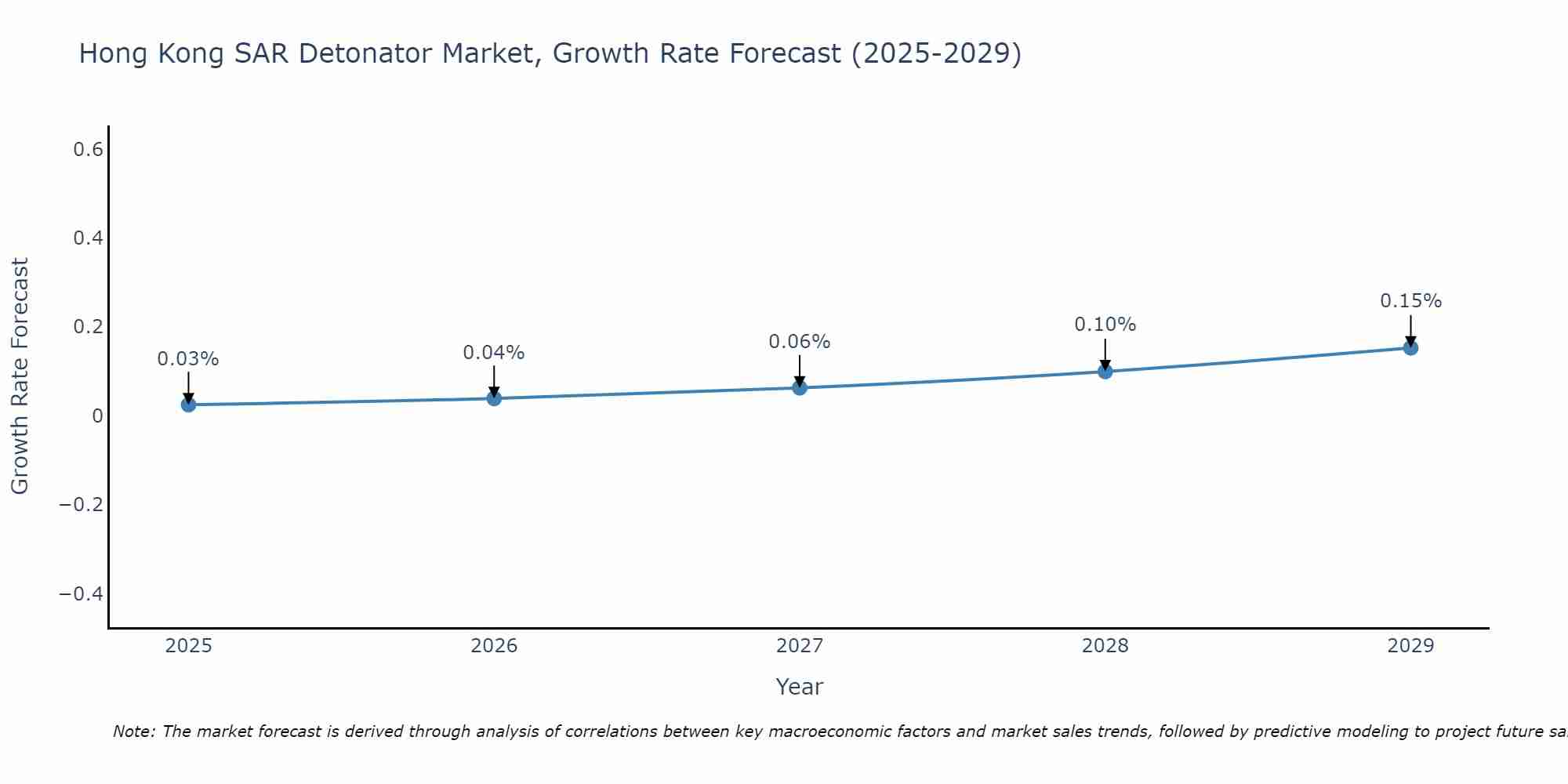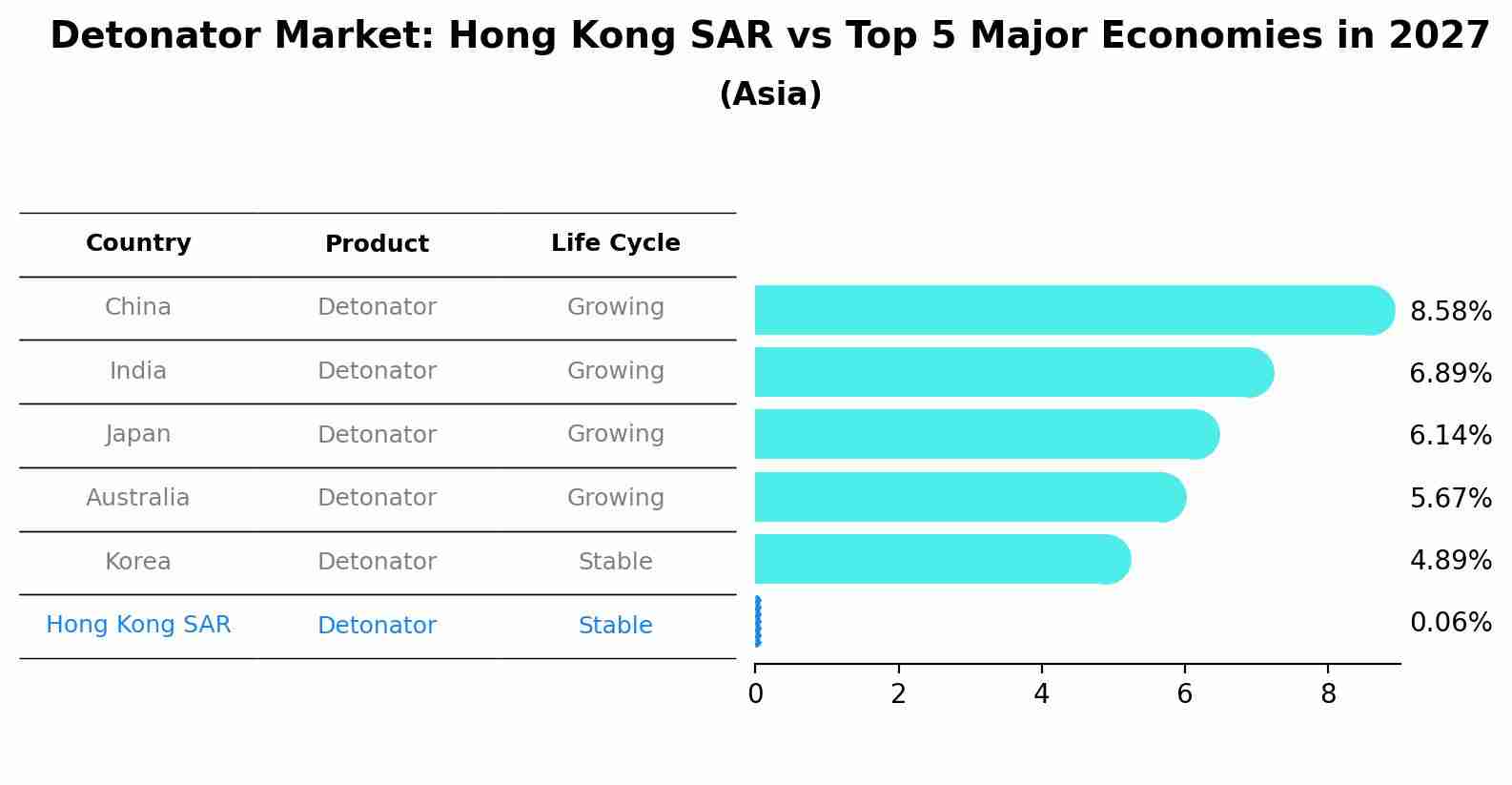Hong Kong Detonator Market (2025-2031) | Value, Outlook, Industry, Size, Share, Trends, Growth, Segmentation, Companies, Analysis, Revenue & Forecast
| Product Code: ETC5362471 | Publication Date: Nov 2023 | Updated Date: Aug 2025 | Product Type: Market Research Report | |
| Publisher: 6Wresearch | Author: Bhawna Singh | No. of Pages: 60 | No. of Figures: 30 | No. of Tables: 5 |
Hong Kong SAR Detonator Market Size Growth Rate
The Hong Kong SAR Detonator Market is likely to experience consistent growth rate gains over the period 2025 to 2029. Commencing at 0.03% in 2025, growth builds up to 0.15% by 2029.

Detonator Market: Hong Kong SAR vs Top 5 Major Economies in 2027 (Asia)
In the Asia region, the Detonator market in Hong Kong SAR is projected to expand at a stable growth rate of 0.06% by 2027. The largest economy is China, followed by India, Japan, Australia and South Korea.

Hong Kong Detonator Market Synopsis
The detonator market in Hong Kong is primarily driven by the construction and mining industries, where precise blasting is essential for project completion. With advancements in technology, electronic detonators are becoming increasingly popular due to their improved accuracy and safety features. The market is also influenced by stringent safety regulations that promote the use of modern, reliable detonators. Nevertheless, factors such as fluctuating raw material prices and potential regulatory changes pose challenges for market growth.
Drivers of the market
The detonator market in Hong Kong is primarily propelled by growth in the construction and mining sectors. As infrastructure development projects expand and mining activities increase, the demand for reliable and efficient detonators rises. Technological advancements in detonator design and safety features have made these products more appealing to industry players. Furthermore, the regulatory framework governing safety in explosive usage supports market expansion, ensuring that businesses adhere to stringent safety standards while maximizing operational efficiency.
Challenges of the market
The Hong Kong detonator market encounters challenges related to strict regulatory frameworks governing explosives and their transportation. Compliance with safety standards is essential, which can lead to increased operational costs for manufacturers. Furthermore, the rising demand for alternative technologies in construction and mining may reduce the market`s reliance on traditional detonators. Market players must also navigate geopolitical tensions that can affect supply chains and distribution.
Government Policy of the market
The sale and use of detonators in Hong Kong are tightly regulated under the Explosive Ordinance. The government has established stringent licensing requirements for manufacturers and distributors, aimed at preventing misuse and ensuring public safety. Additionally, policies include mandatory reporting of any incidents involving explosives, thereby enhancing oversight and security in the market. Compliance with international standards for handling and storage is also required, reflecting the government`s commitment to maintaining safety standards in this sector.
Key Highlights of the Report:
- Hong Kong Detonator Market Outlook
- Market Size of Hong Kong Detonator Market, 2024
- Forecast of Hong Kong Detonator Market, 2031
- Historical Data and Forecast of Hong Kong Detonator Revenues & Volume for the Period 2021-2031
- Hong Kong Detonator Market Trend Evolution
- Hong Kong Detonator Market Drivers and Challenges
- Hong Kong Detonator Price Trends
- Hong Kong Detonator Porter`s Five Forces
- Hong Kong Detonator Industry Life Cycle
- Historical Data and Forecast of Hong Kong Detonator Market Revenues & Volume By Type for the Period 2021-2031
- Historical Data and Forecast of Hong Kong Detonator Market Revenues & Volume By Industrial electric detonators for the Period 2021-2031
- Historical Data and Forecast of Hong Kong Detonator Market Revenues & Volume By Shock Tube Detonators for the Period 2021-2031
- Historical Data and Forecast of Hong Kong Detonator Market Revenues & Volume By Application for the Period 2021-2031
- Historical Data and Forecast of Hong Kong Detonator Market Revenues & Volume By Coal Mines for the Period 2021-2031
- Historical Data and Forecast of Hong Kong Detonator Market Revenues & Volume By Metal Mines for the Period 2021-2031
- Historical Data and Forecast of Hong Kong Detonator Market Revenues & Volume By Non-metal Mines for the Period 2021-2031
- Historical Data and Forecast of Hong Kong Detonator Market Revenues & Volume By Railway/road for the Period 2021-2031
- Historical Data and Forecast of Hong Kong Detonator Market Revenues & Volume By Hydraulic & Hydropower for the Period 2021-2031
- Hong Kong Detonator Import Export Trade Statistics
- Market Opportunity Assessment By Type
- Market Opportunity Assessment By Application
- Hong Kong Detonator Top Companies Market Share
- Hong Kong Detonator Competitive Benchmarking By Technical and Operational Parameters
- Hong Kong Detonator Company Profiles
- Hong Kong Detonator Key Strategic Recommendations
Frequently Asked Questions About the Market Study (FAQs):
1 Executive Summary |
2 Introduction |
2.1 Key Highlights of the Report |
2.2 Report Description |
2.3 Market Scope & Segmentation |
2.4 Research Methodology |
2.5 Assumptions |
3 Hong Kong Detonator Market Overview |
3.1 Hong Kong Country Macro Economic Indicators |
3.2 Hong Kong Detonator Market Revenues & Volume, 2021 & 2031F |
3.3 Hong Kong Detonator Market - Industry Life Cycle |
3.4 Hong Kong Detonator Market - Porter's Five Forces |
3.5 Hong Kong Detonator Market Revenues & Volume Share, By Type, 2021 & 2031F |
3.6 Hong Kong Detonator Market Revenues & Volume Share, By Application, 2021 & 2031F |
4 Hong Kong Detonator Market Dynamics |
4.1 Impact Analysis |
4.2 Market Drivers |
4.2.1 Increase in construction activities in Hong Kong leading to higher demand for detonators |
4.2.2 Growth in mining industry in the region driving the need for detonators |
4.2.3 Technological advancements in detonator manufacturing improving efficiency and safety |
4.3 Market Restraints |
4.3.1 Stringent regulations and safety standards governing the use of detonators |
4.3.2 Fluctuating raw material prices impacting production costs |
4.3.3 Competition from substitute products impacting market share |
5 Hong Kong Detonator Market Trends |
6 Hong Kong Detonator Market Segmentations |
6.1 Hong Kong Detonator Market, By Type |
6.1.1 Overview and Analysis |
6.1.2 Hong Kong Detonator Market Revenues & Volume, By Industrial electric detonators, 2021-2031F |
6.1.3 Hong Kong Detonator Market Revenues & Volume, By Shock Tube Detonators, 2021-2031F |
6.2 Hong Kong Detonator Market, By Application |
6.2.1 Overview and Analysis |
6.2.2 Hong Kong Detonator Market Revenues & Volume, By Coal Mines, 2021-2031F |
6.2.3 Hong Kong Detonator Market Revenues & Volume, By Metal Mines, 2021-2031F |
6.2.4 Hong Kong Detonator Market Revenues & Volume, By Non-metal Mines, 2021-2031F |
6.2.5 Hong Kong Detonator Market Revenues & Volume, By Railway/road, 2021-2031F |
6.2.6 Hong Kong Detonator Market Revenues & Volume, By Hydraulic & Hydropower, 2021-2031F |
7 Hong Kong Detonator Market Import-Export Trade Statistics |
7.1 Hong Kong Detonator Market Export to Major Countries |
7.2 Hong Kong Detonator Market Imports from Major Countries |
8 Hong Kong Detonator Market Key Performance Indicators |
8.1 Number of new construction projects in Hong Kong using detonators |
8.2 Adoption rate of advanced detonator technologies in the market |
8.3 Compliance rate with safety regulations and standards in detonator usage |
9 Hong Kong Detonator Market - Opportunity Assessment |
9.1 Hong Kong Detonator Market Opportunity Assessment, By Type, 2021 & 2031F |
9.2 Hong Kong Detonator Market Opportunity Assessment, By Application, 2021 & 2031F |
10 Hong Kong Detonator Market - Competitive Landscape |
10.1 Hong Kong Detonator Market Revenue Share, By Companies, 2024 |
10.2 Hong Kong Detonator Market Competitive Benchmarking, By Operating and Technical Parameters |
11 Company Profiles |
12 Recommendations | 13 Disclaimer |
- Single User License$ 1,995
- Department License$ 2,400
- Site License$ 3,120
- Global License$ 3,795
Search
Related Reports
- Vietnam System Integrator Market (2025-2031) | Size, Companies, Analysis, Industry, Value, Forecast, Growth, Trends, Revenue & Share
- ASEAN and Thailand Brain Health Supplements Market (2025-2031) | Strategy, Consumer Insights, Analysis, Investment Trends, Opportunities, Growth, Size, Share, Industry, Revenue, Segments, Value, Segmentation, Supply, Forecast, Restraints, Outlook, Competition, Drivers, Trends, Demand, Pricing Analysis, Competitive, Strategic Insights, Companies, Challenges
- ASEAN Bearings Market (2025-2031) | Strategy, Consumer Insights, Analysis, Investment Trends, Opportunities, Growth, Size, Share, Industry, Revenue, Segments, Value, Segmentation, Supply, Forecast, Restraints, Outlook, Competition, Drivers, Trends, Demand, Pricing Analysis, Competitive, Strategic Insights, Companies, Challenges
- Europe Flooring Market (2025-2031) | Outlook, Share, Industry, Trends, Forecast, Companies, Revenue, Size, Analysis, Growth & Value
- Saudi Arabia Manlift Market (2025-2031) | Outlook, Size, Growth, Trends, Companies, Industry, Revenue, Value, Share, Forecast & Analysis
- Uganda Excavator, Crane, and Wheel Loaders Market (2025-2031) | Strategy, Consumer Insights, Analysis, Investment Trends, Opportunities, Growth, Size, Share, Industry, Revenue, Segments, Value, Segmentation, Supply, Forecast, Restraints, Outlook, Competition, Drivers, Trends, Demand, Pricing Analysis, Competitive, Strategic Insights, Companies, Challenges
- Rwanda Excavator, Crane, and Wheel Loaders Market (2025-2031) | Strategy, Consumer Insights, Analysis, Investment Trends, Opportunities, Growth, Size, Share, Industry, Revenue, Segments, Value, Segmentation, Supply, Forecast, Restraints, Outlook, Competition, Drivers, Trends, Demand, Pricing Analysis, Competitive, Strategic Insights, Companies, Challenges
- Kenya Excavator, Crane, and Wheel Loaders Market (2025-2031) | Strategy, Consumer Insights, Analysis, Investment Trends, Opportunities, Growth, Size, Share, Industry, Revenue, Segments, Value, Segmentation, Supply, Forecast, Restraints, Outlook, Competition, Drivers, Trends, Demand, Pricing Analysis, Competitive, Strategic Insights, Companies, Challenges
- Angola Excavator, Crane, and Wheel Loaders Market (2025-2031) | Strategy, Consumer Insights, Analysis, Investment Trends, Opportunities, Growth, Size, Share, Industry, Revenue, Segments, Value, Segmentation, Supply, Forecast, Restraints, Outlook, Competition, Drivers, Trends, Demand, Pricing Analysis, Competitive, Strategic Insights, Companies, Challenges
- Israel Intelligent Transport System Market (2025-2031) | Strategy, Consumer Insights, Analysis, Investment Trends, Opportunities, Growth, Size, Share, Industry, Revenue, Segments, Value, Segmentation, Supply, Forecast, Restraints, Outlook, Competition, Drivers, Trends, Demand, Pricing Analysis, Competitive, Strategic Insights, Companies, Challenges
Industry Events and Analyst Meet
Our Clients
Whitepaper
- Middle East & Africa Commercial Security Market Click here to view more.
- Middle East & Africa Fire Safety Systems & Equipment Market Click here to view more.
- GCC Drone Market Click here to view more.
- Middle East Lighting Fixture Market Click here to view more.
- GCC Physical & Perimeter Security Market Click here to view more.
6WResearch In News
- Doha a strategic location for EV manufacturing hub: IPA Qatar
- Demand for luxury TVs surging in the GCC, says Samsung
- Empowering Growth: The Thriving Journey of Bangladesh’s Cable Industry
- Demand for luxury TVs surging in the GCC, says Samsung
- Video call with a traditional healer? Once unthinkable, it’s now common in South Africa
- Intelligent Buildings To Smooth GCC’s Path To Net Zero













